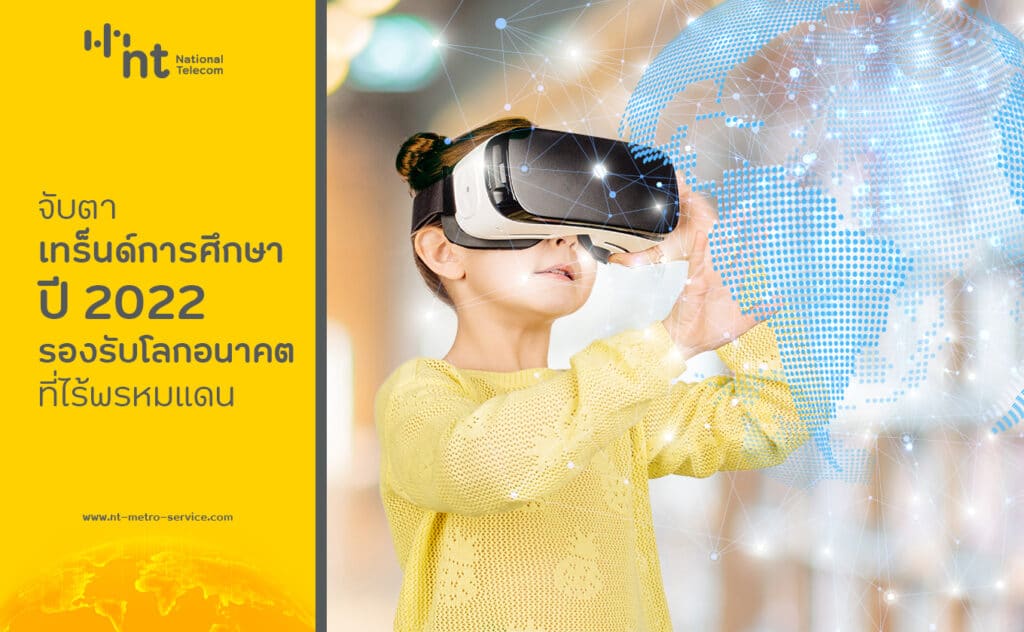These educational trends are going to reshape Thailand’s education system by eliminating all existing learning limitations and maximizing capabilities for both students and teachers. What are these trends? Let’s find out.
From 2020-2021, change was prevalent due to the coronavirus pandemic. All sectors had to adapt in order to keep up with the constant changes that was occurring, in which the education sector was not an exception. Teachers had to leverage new technologies and adjust their curriculum to better suit students. In the meantime, students must also effectively adapt and develop skills that are relevant to the digital age.
As a result, let’s familiarize ourselves with the educational trends in 2022 to see how new technologies are being utilized in education and find out how much it can uplift the level of student interaction.
5 Educational Trends in 2022
1. Trends in AR and VR: Building a Virtual Learning Environment
These immersive technologies are starting to have a role in a variety of industries including gaming, arts and various service sectors. The education sector is also beginning to utilize these technologies, parallel to Albert Einstein’s famous quote, “Imagination is more important than knowledge” because AR and VR have the ability to blend reality and the virtual world into one.
- AR (Augmented Reality), a technology that blurs the line between reality and the virtual world. AR is enabled through the use of mobile phones, computers or other devices. The virtual world is extended to the real world in the form of video clips, pictures or objects. Most importantly, these objects can be interacted with like real objects.

- VR (Virtual reality) is the simulation of an environment that extends to all 360 degrees where the real world and a simulated one is easily distinguishable. VR is enabled through devices such as a VR headset. Users can sense and interact with the simulated environment in the form of sounds, touch or scents making the experience feel even more immersive.
If these 2 technologies were to be used for education purposes, students would be immersed in a simulated environment as if they were in an actual classroom, despite not having to physically travel there. Moreover, these technologies can also be applied to specialized fields such as simulating surgical procedures or patient symptom diagnosis for medical students. Alternatively in business management related fields, they can also be used to simulate real business scenarios without having to commute. Therefore, both these technologies increase flexibility in learning, expand students’ imagination and ability to think outside the box, as well as enhance understanding of the materials taught.
2. Upgrading Traditional Education With Artificial Intelligence (AI)
Artificial intelligence is intelligence demonstrated by computer systems that can analyze, manage and organize information on-par with human counterparts. Given its capabilities, it has been used to replace some human roles. They could also help reduce the workload of teachers and increase student’s convenience while learning such as:
- Help to answer student’s questions: Due to most sessions having time limitations, some questions raised by students may remain unanswered. AI could help answer basic fundamental questions instantly, thus saving time for both parties.
- Personalized learning materials: With the majority of learning now taking place online, new channels for learning now exist through websites and applications utilizing AI in suggesting content that may be of interest to the student. Moreover, AI can also keep track of a students’ performance, reducing teachers’ workload.
- A replacement for teachers: Thailand’s education will be improved through AI by mitigating the risk of human errors. Additionally, analysis using AI is also more accurate and free from human bias.
It is apparent that AI offers intelligence and accuracy on par to that of humans. However, there are certain limitations to this technology. If AI continues to develop, it is perhaps a technology that may play a larger role in the education sector.
3. Learning from real experiences and enhancing children’s imagination
Effective learning does not solely take place in the classroom, but requires parallel exposure outside of the classroom. A combination of these two learning activities could help build new stems of knowledge such as:
- Exchanging ideas: In the case where students have a place to exchange ideas and opinions, simply talking to friends after class will open up new perspectives that might differ from theirs. This could enhance a students’ imagination and help them understand differences in opinions or outlook.

- Practical activities: After classroom learning, practice in a real situation is recommended. This way, students will understand the problem better and learn to solve it in a more effective way.
Therefore, learning from real experiences will help students gain knowledge that is different from that gained from textbooks. In turn, enhancing learning that is aimed to develop their thinking process. This allows students to not only understand the concepts, but also be able to apply it to real scenarios.
4. Hybrid Learning: A New Way of Learning with Emphasis on Flexibility
Hybrid learning is a learning system which allows students to access knowledge in different ways. It is one of the education trends in 2022 where students can interact and learn alongside other students.

การเรียนรู้แบบไฮบริดไม่ได้จำกัดเฉพาะความรู้ที่จำเป็นในห้องเรียนเท่านั้น แต่รวมไปถึงความรู้ทั่วไปหรือในเฉพาะด้าน โดยผู้เรียนสามารถเข้าถึงแหล่งข้อมูลได้ จากทุกที่ผ่านอินเทอร์เน็ต ไม่ว่าจะอยู่ที่ไหนก็สามารถเรียนได้ เช่น
- Article
- Books
- E-Learning Platforms
- Podcast
- Video
- Exams
The goal of hybrid learning is to adjust the learning environment to be suitable for students, where they can meet other learners who are learning about the same subject. By being able to exchange knowledge, ask questions to one another, and understand the content together helps enhance the effectiveness of learning.
One interesting hybrid model comes from a school in Cleveland, USA, where the school allowed older students to commute to school during the pandemic. Moreover, there were proper social distancing precautions where students must sit a certain distance away from one another, while the teacher is allowed to teach from home through an online platform. The model showed great success where students were able to gain a deeper understanding of the materials taught, along with greater interactions with other students as compared to studying at home. Moreover, a survey found that students enjoyed this way of learning more, presenting an interesting model for Thai institutions to adopt in order to potentially increase students’ learning effectiveness.
5. Gamification: A Fun Way to Learn
Another 2022 education trend to look out for is the introduction of games adapted for education. Students are presented with a fun way to learn, resulting in greater interaction where skills taught in the games could also be used in real life.

- Game Objective: Upon the completion of a mission, in order to entice players, a game usually rewards the player with experience points or level ups. These concepts could be adapted to learning such as receiving points upon passing a test or achieving a reward after class completion, thus building students’ motivation.
- Incentives: Apart from being an interesting learning material, another important aspect games offer are incentives. This could come in the form of points that are exchangeable for gifts or prizes, another way of enticing students to learn. It also creates a competitive environment that leads to greater improvement for students.
- Competition and Teamwork: Each game has an unique objective and simulated environment that creates pressure and presents challenges for players. By adapting this concept to education, various emotions arise from students which creates teamwork between students when they face a common challenge or try to out-do their competitors. This helps increase the level of engagement and enjoyment that are both good for learning.
Although this education model is not yet widely used, we believe that with the right adjustments it could become an effective tool for improving Thailand’s education. Moreover, it can increase the effectiveness of teaching and learning by building motivation for students and better meeting their needs.
What institutions, business organizations or individuals can take away from the 2022 education trends presented are insights to help foresee the direction of Thailand’s education; a direction which heavily involves collaboration between students. You could use this article to adapt in preparation for the new norm and what is going to be in demand. For education institutions or tutoring services that require fast, reliable internet or Cloud services to keep up-to-date with the latest trends ahead of competitors, we recommend Solutions from NT which will help you adapt and uplift Thailand’s education in preparation for a borderless future.
References
https://www.nsm.or.th/other-service/676-online-science/
https://www.learneducation.co.th/ai
https://www.brainfit.co.th/en
https://www.lifeeducation.in.th/positive-education/
https://touchpoint.in.th/gamification/
https://www.scimath.org/article-technology/item/8669-2018-09-11-08-06-48


